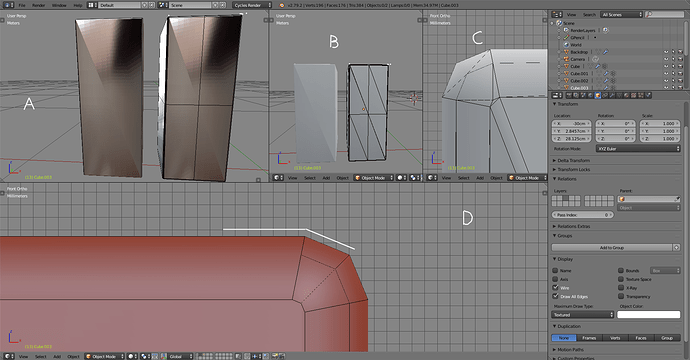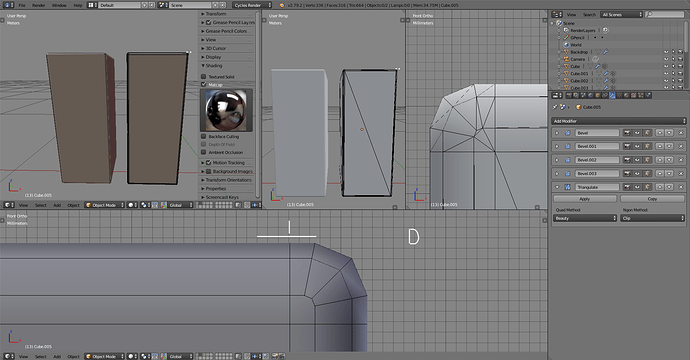There’s so much going on and it’s rather technical so don’t get too frustrated whichever route you choose. It’s definitely not difficult because of you, it’s challenging for everyone.
Also my previous post had a lot of relevant information about the artifacts but wasn’t complete. I’ll continue in this one
A. All large faces are planar (flat) but when smooth shading is enabled, it reveals artifacts again. The front faces are n-gons but that’s not the problem
B. them being n-gons just make it apparent because they’re automatically triangulated as shown.
C. Close-up to show the triangulation in a corner
D. The problem is the shading which tries to hide the edges between all faces. The shading isn’t cut along any edges, and there’s an angle between the flat surface and the rounded one, which is beveled. Smooth shading tries to hide that angle and also affects the flat faces to do it, and because those faces are n-gons that get triangulated in whichever way, the artifacts are very apparent. The shading would behave the same with quads, but might not give as noticeable artifacts. It’s noticeable when comparing reflections though
If those beveled corners are supported with a perimeter loop, the angle between the large faces and the surrounding ones is the same, there’s no angle to smooth out, and the shading looks clean. The smoothing starts from a flat face like before, but is confined near the beveled edges where there are angle changes
Shading uses the vertex normals to get the angles. Using auto smooth to cut the shading on the edges, with or without marking edges as sharp, also changes the normals. The normals are split to make a cut in the shading.
But it’s also possible to change the normals to help with the shading without just cutting them, and without adding perimeter loops which could be tedious and adds geometry. Using the addon is one way to do that
A. reflection and normals before
B. and after. The addon changes the normals and stores them in custom split normals data, which overrides the auto smooth angle setting. It doesn’t put a perfect perpendicular normals against the flat faces, but close enough to hide the artifacts. If you make changes to the mesh, you need to run it again.
As a side note, here’s one tutorial that shows high poly -> low poly workflow for a game asset. The tutorial is for 3ds max so don’t try to follow the steps in Blender, but the process itself is still valid information.
If you check it and get to the point where it says something about smoothing groups, those are used to cut the shading like in Blender.
Also, if you comment on artwork, post critique or such and such, you should be able to get rid of the new user status with <10 posts and get your posts appear right away. The forum FAQ recommends doing so.


